


























































SAFETY AND EFFICIENCY ARE AT THE HEART OF CRANE OPERATIONS ON A CONSTRUCTION SITE.
Improving and ensuring both are always the goals. Mitigating jobsite hazards is one benefit of a crane camera. Either on the tip of the boom or on the hook block, a camera is an essential safety device on any construction crane.
Because of their sheer size and moving parts, cranes can pose a number of hazards on a job site.
The Crosby Group notes the most common cause of fatalities in construction is being struck by an object that falls from a crane. The Tulsa, Okla., material handling solutions provider said other fatalities include being run over by and falling from a crane.
“When a crane operator is lifting and lowering loads, there are blind spots,” according to a Crosby white paper on crane camera technology.
They are unable to see the loads below the hook or boom or actively be able to gauge the surrounding area, said the company.
“A large number of accidents could be avoided with cranes with audio and visual systems installed.”

A camera affords the crane operator an unobstructed view of the
lift from their crane cab.
It also aids the operator in an awareness of where the load is below the hook at all times, as well as the surrounding area. Many hazardous situations can be prevented or mitigated through the use of a camera on the crane. For instance, an operator may not have a line of sight to the load, grounds crew, other equipment, nearby buildings or overhead power lines.
As Crosby points out, this situation can cause accidents to personnel as well as damage to expensive equipment. This hazard also can bring construction to a halt, incurring heavy costs for the contractor.
Camera technology allows the operator to visually see if a load becomes unstable and notice rigging failures before they happen.
Crosby said the device can help the operator accurately steer loads into tight or awkward spaces. It guarantees the operator receives clear instruction from the crew on the ground, whom they can now avoid.

A camera also can quickly alert the crew of a possible hazard involving the crane. The safety tool helps the operator avoid hitting buildings surrounding the lift site and can prevent damage to a contractor’s assets.
Finally, use of crane camera technology has been proven to improve efficiency in the crane operations.
continued on page 8
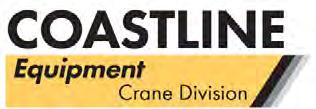












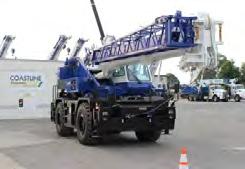













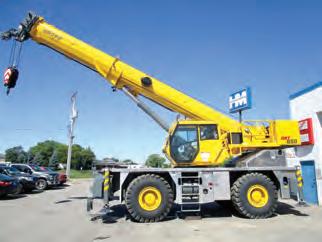


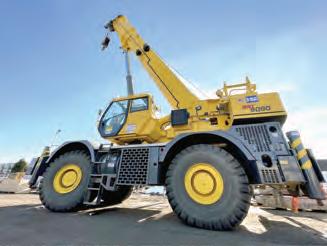
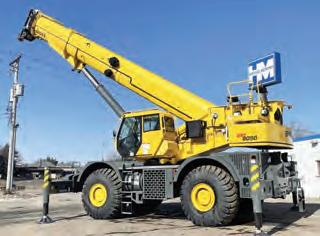

“With a camera system installed to the crane, construction sites will be a safer more efficient environment,” said Crosby.
With camera technology, a crane operator is able to see the loads attached below the hook or boom from any crane cab.
As Crosby explains, of its system, the sound and view from below the camera are transmitted and received wirelessly. The transmission takes place from the antenna system to a screen in the cab.
“This allows the operator to see and hear the load and surroundings,” said Crosby.
It also gives them an unobstructed, live, audio-visual feed of the critical areas that working in the blind would never allow.
Another application popular these days is using the crane’s height and viewpoint to capture real-time imagery of the complete job site.
“This imagery supports project teams with a variety of use cases in productivity, safety, quality assurance and coordination,” noted Sensera.
In this application, cameras can be mounted on the crane tower, or jib provided they are solar/battery powered and wireless.
With wireless technology, no complex wiring is required, said the company, whose devices are suited for this use.
High resolution images and real-time streaming video are provided to the entire project team simultaneously.
“It’s important that the system be rugged, lightweight, completely solar/battery powered and reliable,” advised the company.
“Any industries utilizing cranes can be affected by crane-related accidents,” said the company. “Research and feedback from customers clearly point to the fact that crane camera systems greatly reduce hazards and injuries that bring construction to a halt.”
Cameras also can offer a solution during dark or hazy nighttime crane work, said Carmen Zajicek of Crane Warning Systems.
The Atlanta, Ga., crane system provider noted that while most projects are executed during the day, tight deadlines force others to operate at night.
“These are unfavorable working conditions that increase the need for better lighting for workers working during night shifts,” said Zajicek. “Cameras are safe, quick and efficient solutions for crane operators working under the dim light of dusk and dawn.”
The devices help the operator view all the lifting operations through a bright on-screen display.

The first crane cameras were mounted on the jib and were aimed down onto the load. With this technology, real-time video in the cab provided the operator situational awareness.
Camera manufacturer Sensera Systems said, “We are now seeing other use cases and approaches being taken” with these safety tools.
Today’s camera versions are often mounted on the hook block to provide a more dynamic view of the load and the lift. These versions also use sensors to provide productivity statistics to the team, said the Golden, Colo., company.
From a moving component of the crane, such as the jib, the camera can capture images from multiple viewpoints. The technology is capable of supporting advanced applications joining reality capture, drawings and models with the job schedule.
Current lifting practices do not solve the problem of blind spot lifting, said Taiwanese camera manufacturer Scarlet Tech.
“This is the important role [a] wireless crane hook camera can bring to crane operation safety.”
Mounted on the hook of the crane, the camera eliminates the hazards associated with lifting in the blind. Now the crane operator has live audio and video footage with the ability to see and hear activity below the hook and around the load.
“Crane hook cameras also prove to increase lifting efficiency,” said the company.
That’s because the operator can now clearly see the load while communicating with ground staff.
“Communication becomes much easier and less stressful,” said Scarlet Tech.
With a hook camera system, safety personnel and project managers can monitor the construction site remotely. The system also allows them to access video data for analysis of the lifting operation, the ground crew and the job site.
“Managers can watch the live videos or recorded footage from [a] tablet or Windows PC.”
Location, Location, Location
While the use of a camera on a tower crane can be beneficial,
“With a camera system installed to the crane, construction sites will be a safer more efficient environment.”
The Crosby Group
cameras must not replace a qualified signal person, cautioned haulage broker Safe and Insured.
The Great Britain service provider believes that the technology should be used as a communication tool between operator and signaler.
“Cameras can be attached to the tower crane in various positions,” according to the company.

A camera mounted on the hook block eliminates the need for a zoom lens to see the load below, said the brokerage.
“It provides a view from above and the camera can be accessed at ground level.”
There are disadvantages to this positioning, though. At that spot, the camera is most sensitive to windy conditions. The size of the load may obscure the camera’s viewpoint. And, the camera’s battery power and wireless operating equipment will need recharging.
Mounted on the trolley of a flat-top or saddle crane, the camera is unlikely to be struck or damaged.
Solar power operates the camera, and the view is not sensitive to hook block rotation or the wind.
Disadvantages, according to Safe and Insured, can include the need for a zoom lens to see loads accurately from taller tower cranes.
Another drawback is the need for a personnel basket for access to the camera when its maintenance is required.
With a jib-mounted camera on a luffing crane, power can be furnished via both solar and hard wire, noted the company. The camera is “unlikely to be struck or damaged and the view will cover the load, hook block, hoist rope and lifting accessories,”
they said.
As with a trolley, the jib mount may require a zoom lens on taller cranes and will likely require a personnel basket for maintenance
A “jib-mounted [camera] also requires a pivot mechanism to be installed so the view is not obscured when the jib angle is altered,” said the broker.
In the crane cab, the camera monitor must not restrict the operator’s direct line of sight or impede any of their controls.
One other reminder from the brokerage: The monitor should be able to be seen in direct sunlight.
“Camera systems and their components should be fastened securely to lower the chance of anything falling from the crane,” said the broker.
“When a camera is installed using magnets, extra security tethers also should be installed as a backup.”
Tethers should be fastened to suitable anchor points. And they should be able to take twice the weight of the item secured. Tethers should be as short as possible to lower the chance of snags or contact with other parts of the crane.
“Any carabiners used should be double action locking and [designed] for outdoor use,” said Safe and Insured.
Tower crane cameras should be inspected to confirm the device is working as intended. Confirm that the camera, batteries and associated parts are secure and there is no damage to cables, connectors and security tethers.
“The frequency and responsibilities of the inspections and maintenance vary depending on the positioning of the camera,” said the broker. CQ


Belt Cranes, part of the Belt Group of Companies of Cumberland, Md., has purchased a new Link-Belt 175-ton 175|AT all terrain crane for its taxi crane fleet.


The Belt Group of Companies umbrella includes general construction, paving and road construction and roofing.

Belt Group covers a 70-mi. radius that includes Maryland, Pennsylvania, Virginia and West Virginia in the Allegheny and Appalachian Mountains. The 175|AT was added to its existing fleet of Link-Belt Cranes, which include a 75-ton HTC-8675 and 90-ton HTC-8690, both hydraulic truck cranes.
“The 175|AT crane fits into our company well because we are in the mountains and the 175 holds itself back on down grades and climbs really well for its size,” said Belt Cranes Operator Travis Ryan.
“Also being an all terrain, used for different sites, it’s nice because when in an area that is rough and tight, you have all your wheel configurations. That’s what I like about this
machine. It’s tight for the size of it. You can maneuver it just about wherever you want to with no problem.
One of the 175|AT’s earliest projects included a West Virginia Department of Highways (WVDOH) two-lane bridge project over North Fork Patterson Creek in Maysville, W. Va.
During two separate seven hour road closures, Belt Cranes was able to place eight total beams for the new bridge deck. Most beams were 52 ft. long and 33 in. square prestressed precast concrete, weighing 40,000 lbs.
The 175|AT worked with 90 ft. of boom in the EM1 mode using four part line, and working at a 50 ft radius at the bridge site. The heaviest lift included guard-railing already attached to the bridge deck that weighed 45,000 lbs.
140 ft. radius up to 5,000 lbs.
“We love the boom on this 175AT, and the lighter boom with the 197 feet available to us. That is very valuable to us. Even the foldable jib is an advantage and we like the hydraulically offset full jib. We no longer have to put it down on the ground and remove pins and find something to support the jib and then offset it, and then bring it back into position,” said Dave Madden, executive vice-president and chief operating officer of Belt Group of Companies.
“We have a good relationship with Link-Belt Mid-Atlantic, their sales group and service people. Most of the parts for the Link-Belt’s are U.S.-based so they’re easy to acquire and parts inventory is good if you need something expedited or overnighted,” said Madden.
For more information, visit www.linkbelt.com.



Consorzio Stabile SIS has chosen four Potain top-slewing cranes for a pivotal role in the renovation of one of Italy’s oldest hospitals, Policlinico di Milano.

The project is set to last approximately three years and will require the use of the Potain cranes for the duration of the construction work.
Consorzio Stabile purchased two MDT 269 J12 cranes with a maximum jib length of 213 ft. and two MDT 389 L16 cranes with maximum jib length of 246 ft., which have
been mounted on site with jibs ranging from 180 to 197 ft. in length and heights under hook of up to 226 ft. The cranes will lift heavy loads and maneuver equipment around the 27,508 sq. yd. site.
The project presents particular challenges, including its historic city center location, a single narrow access road to the hospital that must not be blocked, and limited space for maneuvering heavy vehicles, the mobile crane and disassembly operations. To overcome these challenges, Manitowoc engineers, led by Matteo
Pastore, have expertly planned and organized the placement of the cranes.
The team looks forward to continuing to work with Consorzio Stabile SIS to ensure the Policlinico di Milano renovation project’s successful completion, as well as on other construction projects in the future.
Consorzio Stabile, a long-standing partner of Manitowoc, also counts five Grove rough-terrain models and three Potain selferecting models in its fleet of cranes.
For more information, visit www.manitowoc.com.
NessCampbell Crane + Rigging, an established crane and rigging company based in Portland and Seattle, was recently tasked with the transportation of a transformer for Seattle City Light. The customer couldn’t ship the transformer directly to Seattle by railroad. Instead, it was shipped via railroad to Vancouver, Wash., and NessCampbell took it from there.
The transformer weighed an enormous 445,000 lbs. and was 185 ft. in length, 16-ft. wide and 16ft., 8-in. tall, making it a complex and challenging transportation project.
NessCampbell used its custom Lane Loader dual lane trailer specially designed for hauls like this, along with two semi trucks on both ends.
The transportation project required extensive planning and coordination with various state and city entities, including Seattle Metro, to ensure the safety of the public and the successful delivery of the transformer. Due to height restrictions and other limitations, the transportation route took four days to complete.
The project involved a complex de-energizing plan to ensure there was no power in the trolley lines that the transformer passed under. Seattle Metro crews accom-
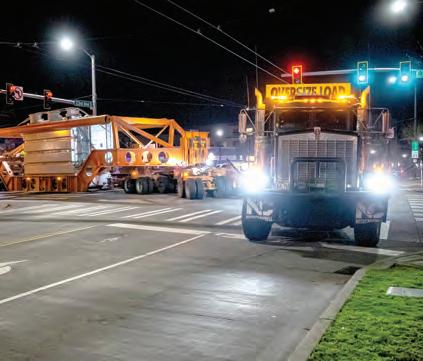
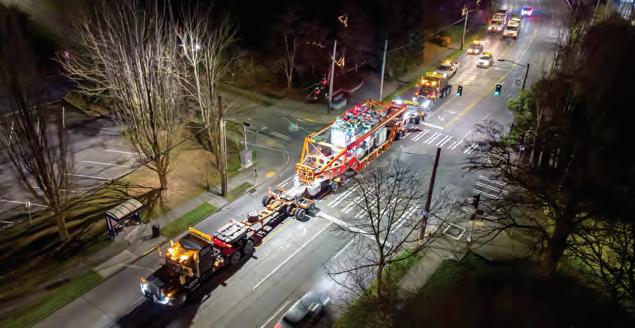
panied the convoy, pushing up trolley lines that the convoy was unable to pass under without coming in contact with them.
Moreover, the transportation team had to manage over 100 no-parking areas to safely maneuver the route. They had to implement a complete street closure around the clock to ensure that homeowners could access their homes safely while the team worked to deliver the transformer.
The team successfully completed the project within two days of direct impact on the site, after nearly six months of planning.
The transportation convoy consisted of a team of highly skilled professionals, including three SDOT troopers, two Metro service crews, two sign and signal crews, two Seattle City Light crews, six traffic control crews, four oversize pilots cars, four man support crews, one superintendent and one project manager. Coordination with five counties in Washington (Clark, Cowlitz, Lewis, Thurston and Pierce) and the city of Portland was necessary for the project to be successful.
The transportation team worked with the Washington State Highway Patrol to provide a trooper escort from the Pierce and King County line to the point where the transformer exited WSDOT right-ofway at I-5 and MLK Way.
In Cowlitz County, the transportation team had to locate and hire an outside engineer to complete an analysis of the transporter to cross the Lexington Bridge over the Cowlitz River in Kelso, Wash. Time was crucial and they had less than a month and a half to the scheduled transport date.
The team reached out to several engineering firms, but most were not able to meet their deadline due to the short time frame and their current workload. They eventually hired a fourth engineering firm from Corvallis, Ore., which completed the work within the specified timeframe and within budget. However, about two weeks into the analysis, they received a notice from Cowlitz County that they had re-rated the bridge and issued new load ratings.
The transportation team immediately reached out to the engineering firm they hired and the engineer worked with the county engineer to discuss the new ratings and their impact on the analysis. The analysis concluded that the lower ratings were not enough to cause the transport combination to fail.

The success of a large transportation project like this one requires extensive planning, meticulous communication and coordination between all parties involved. NessCampbell Crane + Rigging’s specialized haul team had to work with various state and city entities and hire outside engineers to complete the project successfully. The team’s experience demonstrated that large transportation moves could not happen without the support and cooperation of city and county-level authorities. The successful transportation of the 445,000-lbs. transformer was a testament to the team’s dedication and hard work.



5024 N 56th Street Tampa, FL 33610 813-621-8002
Harrisburg, PA 800-325-6455
Philadelphia, PA 800-220-4033
Pittsburgh, PA 800-692-7600
Wilkes-Barre, PA 866-667-6756


Albany, NY 518-357-2200
Syracuse, NY 800-368-6455 Nixon-Egli

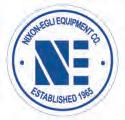

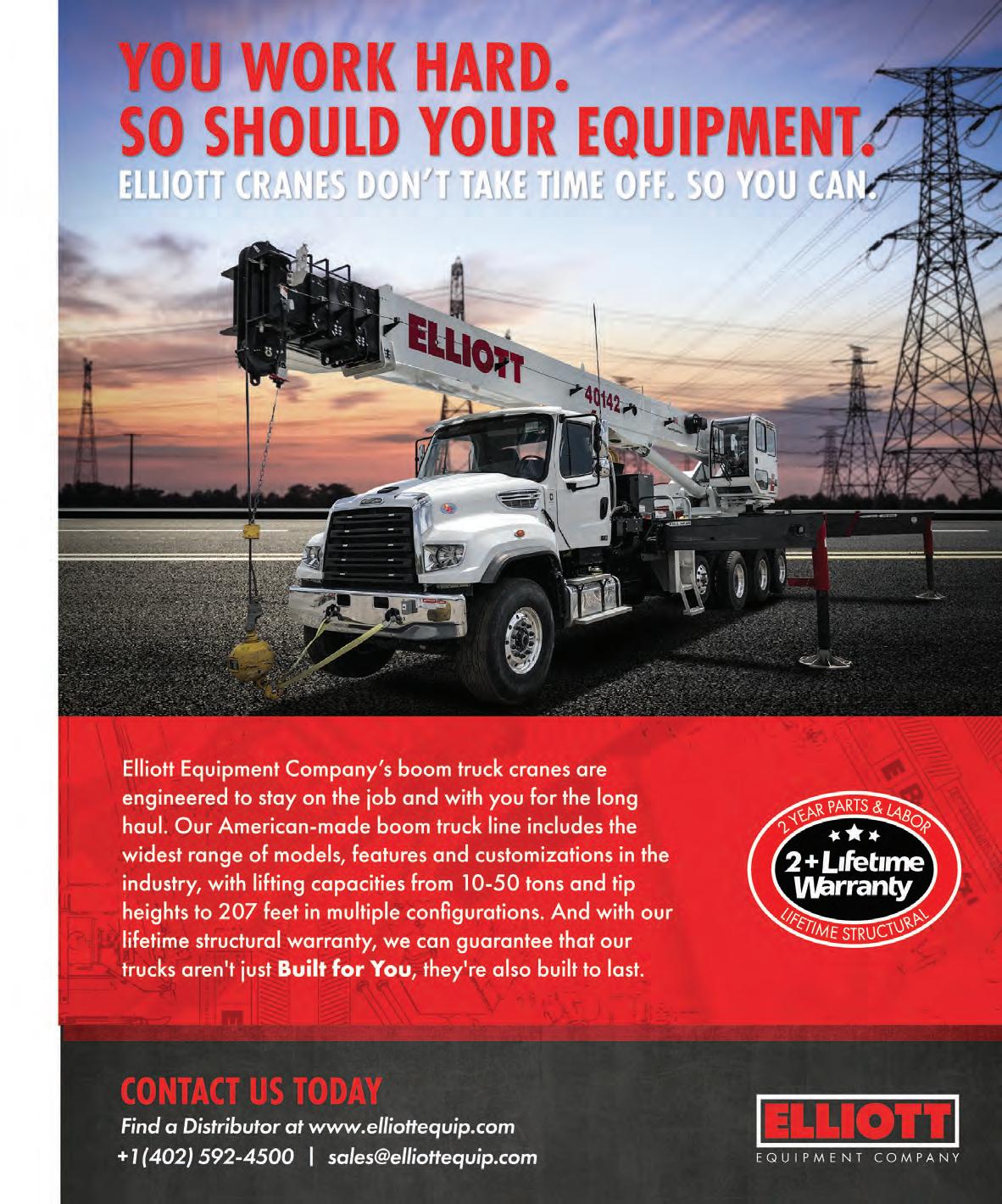
325 N. 5th Street, Bldg. A Sacramento, CA 95811 916-440-8090



At ConExpo 2023, Liebherr presented a mobile crane that takes the combination of mobility, economy and performance to a new level.
The LTM 1100-5.3 offers a powerful 203 ft. telescopic boom and carries up to 37,250 lb. of ballast with a 26,450 lb. axle load on public roads. The new crane also offers economical mobility worldwide, as it can travel with an axle load of only 19,840 lb.
For this reason, Liebherr is presenting the new LTM 1100-5.3 under the slogan “The master of all roads”. It is the second crane in the Liebherr range to feature the new LICCON3 control system.
When designing the LTM 1100-5.3, Liebherr focused above all on lightweight construction to allow as much ballast as possible to be carried with a 26,450 lb. axle load; and to achieve the lowest possible axle loads by reducing ballast. In addition, the new crane was designed with a long, strong telescopic boom in mind.
Even in countries where mobile cranes with a 26,450 lb. axle load are permitted on the roads, operators have been requesting cranes that can be driven with low axle loads and total weights by simply removing the ballast. These models deliver major benefits when it comes to obtaining licenses and route permits. Day-to-day circumstances often require reduced weights, such as when driving over bridges and in inner cities.
When it comes to flexible axle loads, the new LTM 1100-5.3 sets unprecedented standards, the manufacturer said.
With 1,760 lb. of ballast, it reaches a total weight of 94,800 lb. with axle loads of 19,840 lb.
With 9,700 lb. of ballast, it can travel with 22,050 lb. of axle load and a total weight of 105,800 lb.
With an axle load of 26,450 lb., the new 110 ton crane can carry up to 37,250 lb. of counterweights. At 75 percent of the maximum ballast of 49,600 lb., this is a new record for mobile cranes worldwide. This allows the new LTM 1100-5.3 to perform most of its jobs as a taxi crane without additional ballast transport.
Even with maximum ballast, the axle loads of 29,760 lb. are low and evenly distributed across all axles.
The new LTM 1100-5.3 has a narrow width of 8 ft. 4 in. — an additional advantage when driving on roads and construction sites. It is the first 5-axle mobile crane worldwide based on this narrow design, according to the manufacturer.
The new LTM 1100-5.3 offers operators in California a particularly big advantage: it is the first and so far the only 5-axle all-terrain crane to receive Cal-trans approval. This means that it is road-legal in the normal driving condition, with the telescopic boom over the front. Operation with a dolly is not necessary.
This means that the new Liebherr LTM 1100-5.3 is ideal to enter the “truck crane” market, which is particularly popular in the USA, the manufacturer said.
At 203 ft., the telescopic boom is 6 ft. 7 in. longer than the next most powerful Liebherr 5-axle machine, the LTM 1110-5.2. In addition, a 31 to 53 ft. folding jib is available which, as an option, can also be adjusted hydraulically between 0 and 40 degrees. This enables the LTM 1100-5.3 to achieve hoisting heights of up to 249 ft. and radii of up to 210 ft.
ous control system will quickly and easily get to grips with the new version, as the recognition value is very high.
Proven hardware components, such as the mobile operating and display unit BTT, have been adopted. The touchscreen function on the large new display in the superstructure cab means that it is now even easier and more comfortable to control. The way in which the information is shown also has been revised and simplified. In addition, LICCON3 cranes are prepared for telemetry and fleet management as standard.
In the future, crane contractors will be able to view and evaluate all the relevant data using the MyLiebherr customer portal.
As a result of the high synergy effects involved, Liebherr is launching the new operator’s cab at the same time as the LICCON3 control system. The modern design features premium materials and timeless lines as well as delivering a whole host of improvements for the crane operator. These include the new multifunction steering wheel, side roller blind on the operator’s door, improved instruments and modules as well as new displays.
Options such as a central locking system with remote key and the “Coming and Leaving Home” function also offer additional convenience.
A new automatic heating and air-conditioning system in the operator’s cab and in the crane cab features an adapted design and ensures a high level of comfort. A sun sensor detects strong sunshine and automatically adjusts the heating settings.
Other options include a 6 ft. 7 in. assembly jib and a side-folding rooster sheave, which offer additional flexibility in use.
The new 110 ton crane offers extra safety, flexibility and lifting capacity due to the VarioBase variable outrigger. Greater flexibility on the construction site also is provided by the standard VarioBallast, which allows the ballast radius to be adjusted between 13 ft. 1 in. and 16 ft. 8 in.
The third generation of the LICCON (Liebherr Computed Control) system relies on proven control features, but also includes a completely new software package and programming language as well as a faster databus, significantly more storage space and more computing power. Crane operators who are familiar with the previ-
The lighting packages for the crane cab, superstructure, rear of the vehicle, front headlights, lattice fly jib and telescopic boom have been optimized and can be operated with LEDs. The benefits of LED technology include a longer service life and superior lighting performance.
The new LTM 1100-5.3 features the innovative DynamicPerform coupling module which ensures virtually wear-free starting and maneuvering without overheating for the modular ZF TraXon gear unit, as it transmits the engine output via an oil-cooled clutch plate pack. The friction heat generated when starting is dissipated in the clutch oil and supplied to the vehicle’s cooling system via an oil/water heat exchanger. Operators benefit from greater efficiency and lower maintenance costs.
For more information, visit www.liebherr.com.
The new LTM 1100-5.3 has a narrow width of 8 ft. 4 in. — an additional advantage when driving on roads and construction sites. It is the first 5-axle mobile crane worldwide based on this narrow design, according to the manufacturer.
obelco’s G-3 series crawler cranes were on display at Kobelco’s exhibit at ConExpo-Con/AGG.
These “Repowered” cranes have been created from end users and real jobsite experiences, incorporating transport, assembly and operator friendly concepts. Other features include boom, carbody and track side frame structures designed with ease of transport in mind. The new cab and design of the cranes add to the operator’s comfort and safety.

All G-3 Series models have been re-engineered with the Isuzu Tier IV compliant engine, known for its reliability, fuel efficiency and quiet operation. Other new features of the G-3 Series include a new cab design offering improved visibility. The cab includes new features such as blue tooth and USB capabilities.
The G-3 also has been updated with a new paint scheme for a more stylish look.
Kobelco has maintained all the previous hydraulic systems, crane travel system and other components that have made Kobelco known for being an “Operator Friendly” and reliable crane .
The G-3 Series has also maintained the value-added standard features as before — large touch screen LMI, swing limiter, selferection capabilities, fuel saving G-Modes, KCROSS Telematics, and Boom and Jib commonality with the previous models.
CK1600G-3
The CK1600G-3 has a maximum lifting capacity of 350,000 lbs. Its boom length spans from 50 to 250 ft. The maximum boom + jib combination is 90 + 40 ft. The crawler’s engine is a 362-hp 2,000-rpm ISUZU fourcycle, water-cooled, direct-injection, turbocharged model. The crawler’s fuel tank holds 106 gallons.
Its main and auxiliary winches have a maximum line speed of 393 ft./min., and a rated single-line line pull of 52,500 lb/f. It travels at .81 mph, has an operating weight of 309,000 lbs., transport weight of 84,830 lbs., and 121,300 lbs. of counterweight.
CK2000G-3
The CK2000G-3 has a maximum lifting capacity of 352,800 lbs. Its nested boom length spans from 50 to 280 ft. The maximum boom + jib combination is 240 + 100 ft. The crawler’s engine is a 362-hp 2,000-rpm ISUZU four-cycle, water-cooled, direct-injection, turbo-charged model. The crawler’s fuel tank holds 106 gallons.
Its main and auxiliary winches have a maximum line speed of 361 ft./min., and a rated single-line line pull of 57,100 lb/f. It travels at .62 mph, has an operating weight of 439,385 lbs., transport weight of 106,715 lbs., and 165,900 lbs. of counterweight.
CK2750G-3
The CK2750G-3 has a maximum lifting capacity of 550,000 lbs. Its nested boom length spans from 50 to 300 ft. The maximum
boom + jib combination is 250 + 100 ft. The crawler’s engine is a 362-hp 2,000-rpm ISUZU four-cycle, water-cooled, direct-injection, turbo-charged model. The crawler’s fuel tank holds 106 gallons. Its main and auxiliary winches have a maximum line speed of 360 ft./min., and a rated single-line line pull of 56,700 lb/f. It travels at .69 mph, has an operating weight of 485,155 lbs., transport weight of 101,475 lbs., and 200,650 lbs. of counterweight.
1.Wide Variety of Attachments
Various kinds of attachments are available ranging from standard crane configuration, including fixed jib, heavy fixed jib and luffing jib, which are most suitable for multipurpose works, including luffing jib, for the heaviest lifts. These attachments make it possible to provide the most suitable solutions in accordance with the individual jobsite requirements. Kobelco designed these cranes taking into consideration maximum compatibility with previous models, the manufacturer said.
After in-depth marketing research, Kobelco positioned the G-3 models to provide enhanced lifting capacity.

To achieve maximum ease of operation, the specifications are optimized for the actual jobsite environment. The performance of the undercarriage has been enhanced to operate with high ground clearance and outstanding propelling performance, while minimizing the overall footprint.
The G-3 models inherited the reliable Kobelco hydraulic control system which has achieved a superior reputation for many years. In order to correspond to specific jobsite needs, a free-fall winch (optional) also is available.
4.
The cab has been re-designed for an operator-friendly environment taking into consideration comfort, ease of operation and safety. The extra-wide full front cab windows offer excellent visibility. An intuitive-designed Moment Limiter monitor makes it simple for anyone to quickly master the operation with easily understandable pictograms and a touch screen panel. Another new addition to the cab is the blue-tooth and USB capabilities.
The new G-3 series cranes lifting capacities range from 80 to 275 U.S. tons for North America. The G-3 series was newly designed, upgraded and improved from the customer’s point of view with safety, reliability and efficiency in mind.
Kobelco’s Cranes are renowned for smart engineering — aiming to increase versatility and flexibility with productivity boosting technical advances — from advanced winch systems to self-diagnostic multi-display monitors. All designed to give users a competitive edge and provide top performance.
Kobelco’s CK1600G-3, CK2000G-3 and CK2750G-3 were showcased at ConExpo 2023.
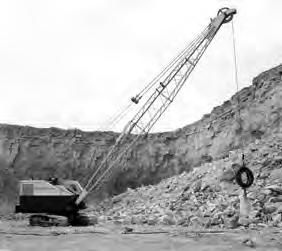




Traction wheels, such as under this Marion Type 7, were designed to provide mobility. We can only guess it’s working from a flat car due to problems accessing this particular work. The outriggers on the flatcar suggest this was not a brief situation.

WESTERN PACIFIC CRANE & EQUIPMENT
www.wpcrane.com
8600 Calabash Ave. Fontana, CA 92335 562/286-6618
1500 Madruga Road
Lathrop, CA 95330 855/927-2637
275 W. Larch Road Tracy, CA 95304 209/597-3824
3521 Alken Street
Bakersfield, CA 93308 855/927-2637
19602 60th Avenue NE
Arlington, WA 98223
253/254-7950
91-210 Kalaeloa Blvd.
Kapolei, HI 96707 808/682-7263
8912 NE Vancouver Way
Portland, OR 97211 971/202-4002
6720 Arctic Blvd.
Anchorage, AK 99518 855/342-7263
WPCE - CANADA 9538 195th Street
Surrey, BC V4N 4G2 855/342-7263
KIRBY-SMITH MACHINERY INC

www.kirby-smith.com
Oklahoma City, OK 405/495-7820
Tulsa, OK 918/438-1700
McAlester, OK 918/310-1550
Kansas City, KS 913/850-6300
St. Louis, MO 314/729-0125
RING POWER CRANE
www.ringpowercrane.com

St. Augustine, FL 904/494-1219
Pompano Beach, FL 954/977-5010
Orlando, FL 407/855-6195
Tampa, FL 813/671-3700
Union City, GA 770/774-7300
Concord, NC 704/795-3636
Aiken, SC 843/818-1954
STEPHENSON EQUIPMENT, INC.

www.stephensonequipment.com
Philadelphia, PA 800/220-4033
Harrisburg, PA 800/325-6455
Wilkes-Barre, PA 866/667-6756
Pittsburgh, PA 800/692-7600
Syracuse, NY 800/368-6455
Albany, NY 518/357-2200
CLEVELAND CRANE & SHOVEL SALES INC.

www.craneandshovel.net
26781 Cannon Road Cleveland, OH 44146
440/439-4749
Toll Free: 800/362-8494
aforepaugh@craneandshovel.net
HOFFMAN EQUIPMENT CO.
www.hoffmanequip.com

New Jersey Corporate Headquarters 300 S. Randolphville Rd. Piscataway, NJ 08854 732/752-3600
South Jersey 1330 Hurffville Rd. Deptford, NJ 08096 856/227-6400
New York 1144 Zerega Ave. Bronx, NY 10462 718/822-1180
Mid-Hudson Valley 1440 Route 9W Marlboro, NY 12542 845/236-3000
Long Island 22 Peconic Ave. Medford, NY 11763 631/207-2900
Pennsylvania Philadelphia Metro Area 120 Gordon Dr. Lionville, PA 19341 610/363-9200
MGX EQUIPMENT SERVICES, LLC
www.mgxequipment.com
Baltimore, MD 443/399-7100
Baton Rouge, LA 225/251-7500
Belle Chasse, LA 504/394-7400
Billings, MT 406/698-6768
Birmingham, AL 205/661-1323
Dallas, TX 972/986-0910
Houston, TX 713/433-6411
Norfolk, VA 757/935-4300
Phoenix, AZ 602/232-0660
Salt Lake City, UT 801/297-8500
Winston-Salem, NC 336/582-7400
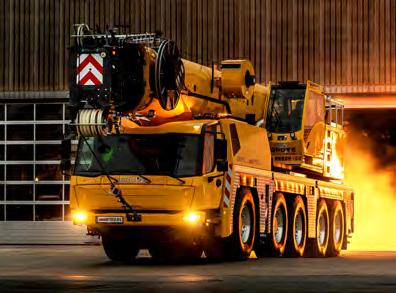

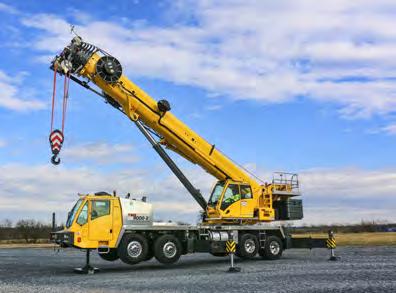









American Crawler Crane Helps Build University Science Building

In this photo dated Oct. 27, 1967, Harry Jackson Forepaugh uses a new American 40-ton crawler crane to build Cleveland State University’s Science Building. H.J. Forepaugh & Sons was a general contractor based in Bedford, Ohio.

Forepaugh’s construction business built most of the schools in the Cleveland area, including Cleveland State University, and the John F Kennedy, Parma High, Valley Forge, Bedford and Twinsburg high schools.
In addition to the American crane pictured, he also owned other cranes, including a Grove RT60S and a 15-ton cab down Pettibone, plus some backhoes and forklifts. CQ
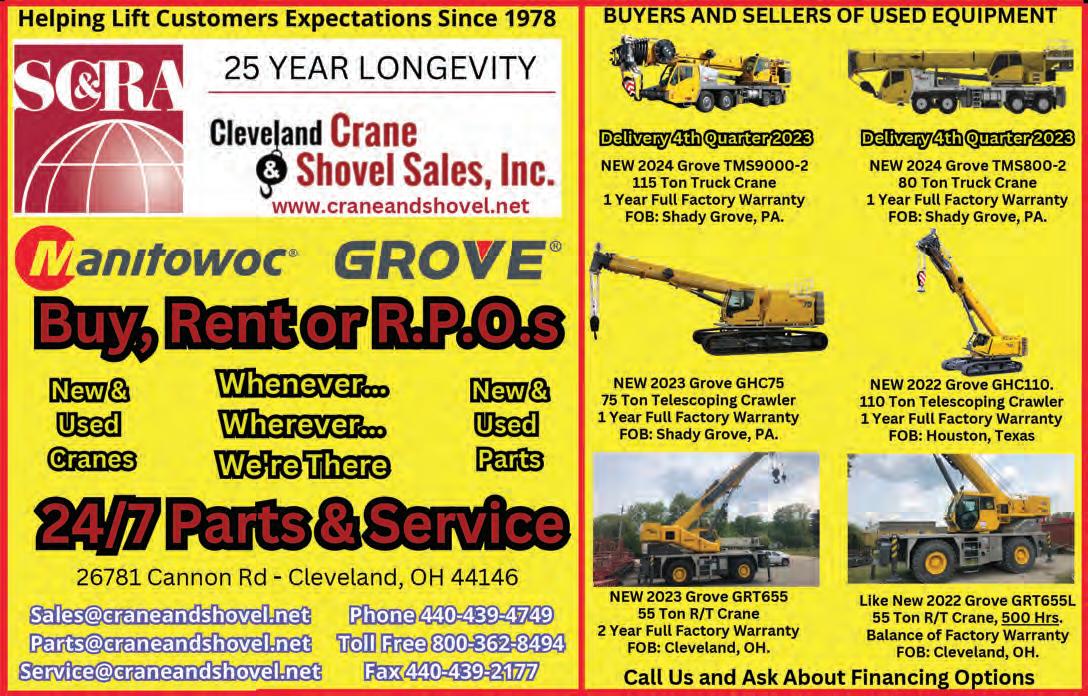
Altaequipment.com


18405 115th Avenue Orland Park, IL 60467 877-399-6430
420 Nolen Drive South Elgin, IL 60177 877-399-6430
2500 Westward Drive Spring Grove, IL 60081 815-581-1479
613 E Stevenson Road Ottawa, IL 61350 815-587-7610
1035 Wylie Drive Bloomington, IL 61705 888-693-2271
480 Blaine Street Gary, IN 46406 219-240-0268
empirecrane.com
7021 Performance Drive N. Syracuse, NY 13212 800-342-7575

9 Finderne Avenue, Ste 7 Bridgewater, NJ 08807 908-203-0400

12 Mear Road Holbrook, MA 02343 508-868-7734

coastlinecd.com
325 N. 5th Street, Bldg. A Sacramento, CA 95811 916-440-8090

Santa Ana, CA 714-265-6550
Las Vegas, NV 702-399-2700
Meridian, ID 208-888-3337
smequipment.com
14925 South Main St. Houston, TX 77035 713-721-7070
Dallas, TX 214-391-4000
Corpus Christi, TX 361-289-2782
Tulsa, OK 918-224-2000
exactcrane.com



Serving Ohio, Michigan, W. Pennsylvania, Kentucky
28985 Ambina Drive Solon, OH 44139 440-349-1999
www.kirby-smith.com

Oklahoma City, OK 800-375-3339
Tulsa, OK
918-438-1700
McAlester, OK 918-310-1550
Kansas City, KS 913-850-6300
St. Louis, MO 314-729-0125
Dallas, TX 214-371-7777
Fort Worth, TX 817-378-0600
Abilene, TX 325-692-6334
Waco, TX 254-261-1370
Amarillo, TX 806-373-2826
Lubbock, TX 806-745-2112
Odessa, TX 432-333-7000
www.mgxequipment.com

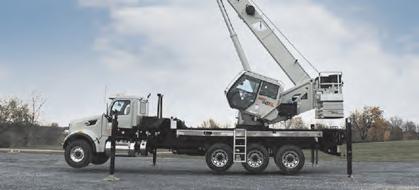



Baltimore, MD 443-399-7100
Baton Rouge, LA 225-251-7500
Belle Chasse, LA 504-394-7400
Billings, MT 406-698-6768
Birmingham, AL 205-661-1323
Dallas, TX 972-986-0910
Houston, TX 713-433-6411
Norfolk, VA 757-935-4300
Phoenix, AZ
602-232-0660
Salt Lake City, UT 801-297-8500
Winston-Salem, NC 336-582-7400
New York City Bronx, NY 718-822-1180

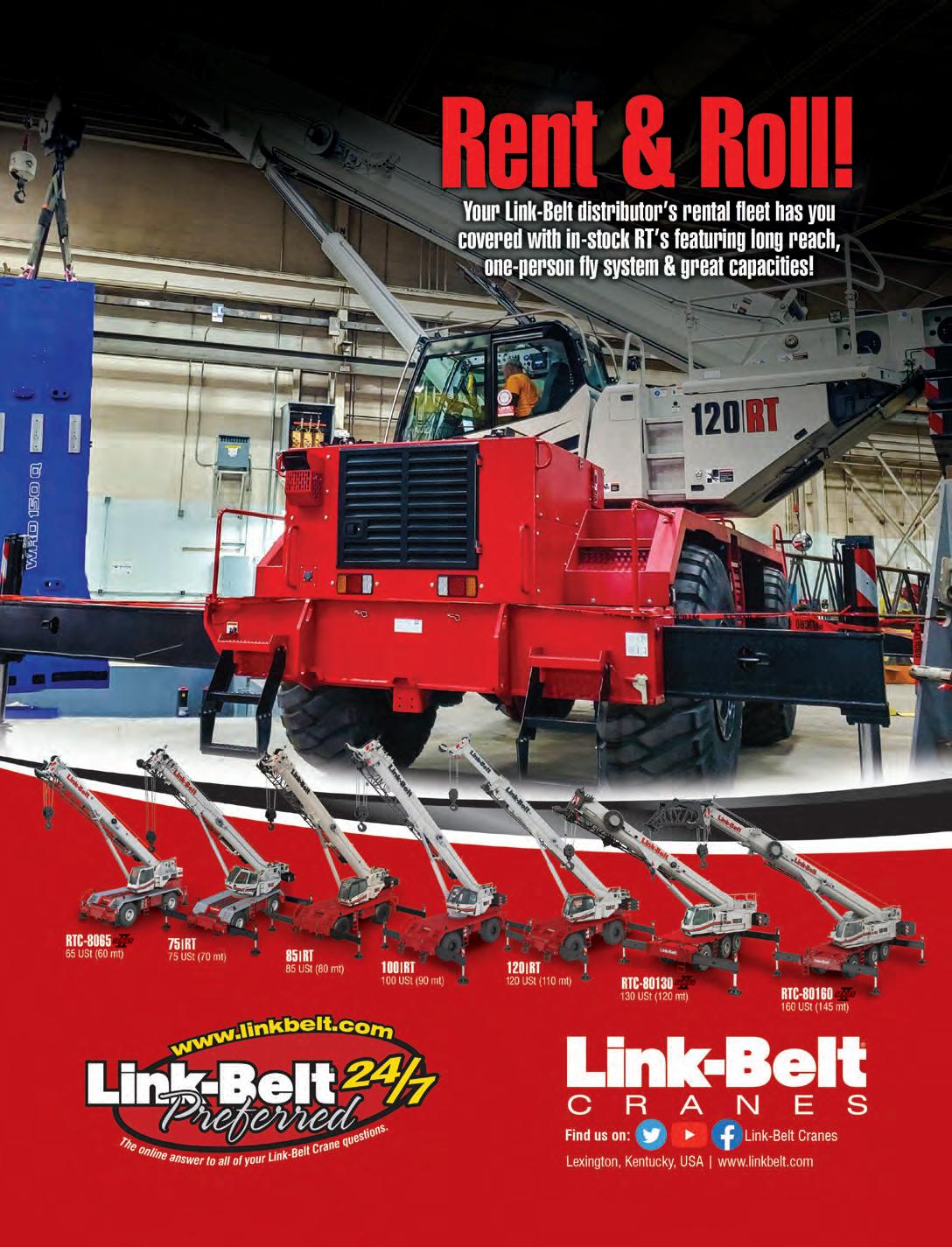
Alta Equipment Company
www.altaequipment.com
Byron Center, MI (616) 878-7450
New Hudson, MI (248) 356-5200
Flint (Burton), MI (810) 744-4840
Traverse City, MI (231) 943-3700
Detroit, MI (313) 394-1811
Atlantic & Southern Equipment
www.atlanticandsouthern.com
Birmingham, AL (205) 951-6656
Theodore, AL (251) 443-5229
Lake City, GA (404) 361-1100
Central/Eastern, TN (888) 951-6656
Columbus Equipment Company
www.columbusequipment.com
Columbus (614) 443-6541
Toledo (419) 872-7101
Cincinnati (513) 771-3922
Richfield (330) 659-6681
Cadiz (740) 942-8871
Dayton (937) 879-3154
Massillon (330) 833-2420
Zanesville (740) 455-4036
Painesville (440) 352-0452
Piketon (740) 289-3757
General Equipment & Supplies
www.genequip.com
Shakopee, MN (952) 224-1500
Minot, ND (701) 852-0479
Fargo, ND (800) 437-2924
Bismarck, ND (701) 223-9700
Williston, ND (701) 572-0570
Kelly Tractor Co.
Crane & Foundation Equipment
www.kellytractor.com
Clewiston, FL (863) 983-8177
Davie, FL (954) 581-8181
Ft. Myers (239) 693-9233
Mulberry, FL (863) 205-2537
Miami, FL (305) 592-5360
Orlando, FL (407) 568-8055
West Palm Beach, FL (561) 683-1231
Link-Belt Construction Equipment Mid-Atlantic

www.link-beltmidatlantic.com
Ashland, VA (800) 552-3837
Chesapeake, VA (800) 342-3248
Frederick, MD (833) 546-5235
Nixon-Egli Equipment Co.
www.nixonegli.com
Ontario, CA (909) 930-1822
Tracy, CA (209) 830-8600
Rudd Equipment Company
www.ruddequipment.com
Louisville, KY (800) 283-7833
Corbin, KY (606) 528-9440
Prestonsburg, KY (606) 874-2104
Evansville, IN (812) 867-6661
Ft. Wayne, IN (260) 482-3681
Indianapolis, IN (317) 247-9125
St. Louis, MO (314) 487-8925
Clearfield, PA (814) 765-8500
Leetsdale, PA (412) 741-1731
Nitro, WV (304) 755-7788
Transport Equipment Sales
www.tes-inc.net
South Kearny, NJ (973) 589-4100
Triad Machinery
www.triadmachinery.com
Portland, OR (503) 254-5100
Eugene, OR (541) 342-7700
Bend/Prineville, OR (541) 447-5293
Seattle/Tacoma, WA (253) 722-5560
Spokane, WA (509) 534-1900
Mt. Vernon, WA (360) 488-3948
Wood’s CRW Corp
www.woodscrw.com
Carlisle, PA (717) 795-0700
Central Square, NY (315) 676-2008
Williston, VT (802) 658-1700
North Oxford, MA (508) 499-1950
